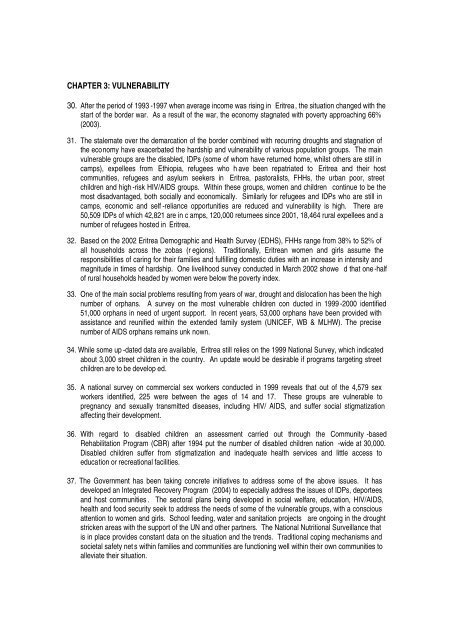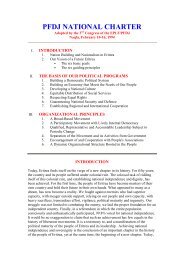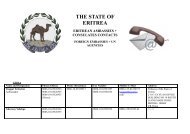Common Country Assessment (CCA) - ECSS | Eritrean Center for ...
Common Country Assessment (CCA) - ECSS | Eritrean Center for ...
Common Country Assessment (CCA) - ECSS | Eritrean Center for ...
Create successful ePaper yourself
Turn your PDF publications into a flip-book with our unique Google optimized e-Paper software.
CHAPTER 3: VULNERABILITY<br />
30. After the period of 1993 -1997 when average income was rising in Eritrea, the situation changed with the<br />
start of the border war. As a result of the war, the economy stagnated with poverty approaching 66%<br />
(2003).<br />
31. The stalemate over the demarcation of the border combined with recurring droughts and stagnation of<br />
the economy have exacerbated the hardship and vulnerability of various population groups. The main<br />
vulnerable groups are the disabled, IDPs (some of whom have returned home, whilst others are still in<br />
camps), expellees from Ethiopia, refugees who h ave been repatriated to Eritrea and their host<br />
communities, refugees and asylum seekers in Eritrea, pastoralists, FHHs, the urban poor, street<br />
children and high -risk HIV/AIDS groups. Within these groups, women and children continue to be the<br />
most disadvantaged, both socially and economically. Similarly <strong>for</strong> refugees and IDPs who are still in<br />
camps, economic and self -reliance opportunities are reduced and vulnerability is high. There are<br />
50,509 IDPs of which 42,821 are in c amps, 120,000 returnees since 2001, 18,464 rural expellees and a<br />
number of refugees hosted in Eritrea.<br />
32. Based on the 2002 Eritrea Demographic and Health Survey (EDHS), FHHs range from 38% to 52% of<br />
all households across the zobas (r egions). Traditionally, <strong>Eritrean</strong> women and girls assume the<br />
responsibilities of caring <strong>for</strong> their families and fulfilling domestic duties with an increase in intensity and<br />
magnitude in times of hardship. One livelihood survey conducted in March 2002 showe d that one -half<br />
of rural households headed by women were below the poverty index.<br />
33. One of the main social problems resulting from years of war, drought and dislocation has been the high<br />
number of orphans. A survey on the most vulnerable children con ducted in 1999 -2000 identified<br />
51,000 orphans in need of urgent support. In recent years, 53,000 orphans have been provided with<br />
assistance and reunified within the extended family system (UNICEF, WB & MLHW). The precise<br />
number of AIDS orphans remains unk nown.<br />
34. While some up -dated data are available, Eritrea still relies on the 1999 National Survey, which indicated<br />
about 3,000 street children in the country. An update would be desirable if programs targeting street<br />
children are to be develop ed.<br />
35. A national survey on commercial sex workers conducted in 1999 reveals that out of the 4,579 sex<br />
workers identified, 225 were between the ages of 14 and 17. These groups are vulnerable to<br />
pregnancy and sexually transmitted diseases, including HIV/ AIDS, and suffer social stigmatization<br />
affecting their development.<br />
36. With regard to disabled children an assessment carried out through the Community -based<br />
Rehabilitation Program (CBR) after 1994 put the number of disabled children nation -wide at 30,000.<br />
Disabled children suffer from stigmatization and inadequate health services and little access to<br />
education or recreational facilities.<br />
37. The Government has been taking concrete initiatives to address some of the above issues. It has<br />
developed an Integrated Recovery Program (2004) to especially address the issues of IDPs, deportees<br />
and host communities . The sectoral plans being developed in social welfare, education, HIV/AIDS,<br />
health and food security seek to address the needs of some of the vulnerable groups, with a conscious<br />
attention to women and girls. School feeding, water and sanitation projects are ongoing in the drought<br />
stricken areas with the support of the UN and other partners. The National Nutritional Surveillance that<br />
is in place provides constant data on the situation and the trends. Traditional coping mechanisms and<br />
societal safety net s within families and communities are functioning well within their own communities to<br />
alleviate their situation.





